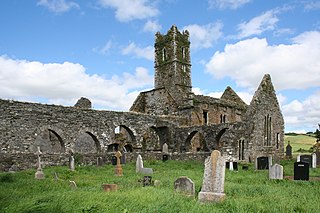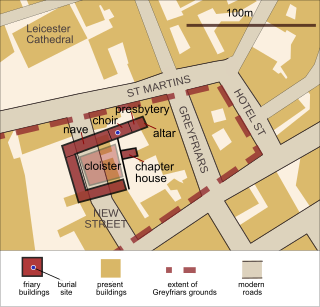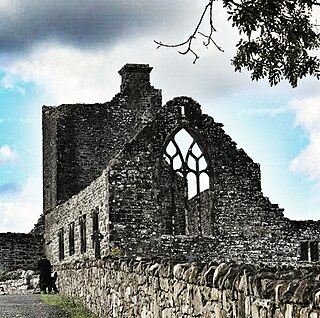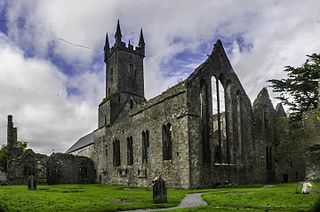
Timoleague Friary, also known as Timoleague Abbey, is a ruined medieval Franciscan friary in Timoleague, County Cork, Ireland, on the banks of the Argideen River overlooking Courtmacsherry Bay. It was built on the site of an early Christian monastic site founded by Saint Molaga, from whom the town of Timoleague derives its name. The present remains date from roughly the turn of the fourteenth century and were burnt down by British forces in the mid-seventeenth century, at which point it was an important ecclesiastical centre that engaged in significant trade with Spain.

Kilcrea Friary is a ruined medieval abbey located near Ovens, County Cork, Ireland. Both the friary and Kilcrea Castle, located in ruin to the west, were built by Observant Franciscans in the mid 15th century under the invitation of Cormac Láidir MacCarthy, Lord of Muskerry, as protection from English troops.

The Buttevant Franciscan Friary is a ruined 13th-century Franciscan friary is situated in the middle of the town of Buttevant, County Cork, Ireland. The Augustinian friary in nearby Ballybeg is often confused with the Buttevant Franciscan Friary in historical documents.

Quin Abbey, is a ruined Franciscan abbey in Quin, County Clare, Ireland. It was built for Fathers Purcell and Mooney, friars of the Franciscan order.

Greyfriars Church is an evangelical Anglican church, and former Franciscan friary, in the town centre of Reading in the English county of Berkshire. The church forms part of the Church of England's Diocese of Oxford.
Svendborg Friary was a Franciscan friary in Svendborg, on the island of Funen, in the present Region of Southern Denmark, and was one of the earliest Franciscan foundations in Denmark. Like almost all Danish religious houses it was dissolved during the Protestant Reformation of the 16th century.
Holbaek Priory was a small Dominican monastery in Holbæk, Denmark.

Greyfriars in Canterbury was the first Franciscan friary in England.

Derby Dominican Priory, also known as Derby Black Friary, or Blackfriars, Derby, was a Dominican priory situated in the town of Derby, England. It was also named in different sources as a friary, monastery and convent, but was officially a priory as it was headed by a prior and the Dominican Order calls all their houses Priories. The "Black" came from the colour of the mantles worn by the friars of the order.
Dorchester Friary, also known as Dorchester Priory, was a Franciscan friary formerly located in Dorchester, Dorset, England.

Blackfriars Priory was a medieval Dominican priory dating back to the thirteenth century. The remains of the priory, located in Hereford, England, consist of monastery ruins, a cemetery, and a stone preaching cross. The ruins are surrounded by a rose garden established by the local community in 1964.

Boston Friary refers to any one of four friaries that existed in Boston, Lincolnshire, England.

Greyfriars, Leicester, was a friary of the Order of Friars Minor, commonly known as the Franciscans, established on the west side of Leicester by 1250, and dissolved in 1535. Following dissolution the friary was demolished and the site levelled, subdivided, and developed over the following centuries. The locality has retained the name Greyfriars particularly in the streets named "Grey Friars", and the older "Friar Lane".

Austin Friars, London was an Augustinian friary in the City of London from its foundation, probably in the 1260s, until its dissolution in November 1538. It covered an area of about 5.5 acres a short distance to the north-east of the modern Bank of England and had a resident population of about 60 friars. A church stood at the centre of the friary precinct, with a complex of buildings behind it providing accommodation, refreshment and study space for the friars and visiting students. A large part of the friary precinct was occupied by gardens that provided vegetables, fruit and medicinal herbs.

Ipswich Blackfriars was a medieval religious house of Friars-preachers (Dominicans) in the town of Ipswich, Suffolk, England, founded in 1263 by King Henry III and dissolved in 1538. It was the second of the three mendicant communities established in the town, the first being the Greyfriars, a house of Franciscan Friars Minors, and the third the Ipswich Whitefriars of c. 1278–79. The Blackfriars were under the Visitation of Cambridge.
Llanfaes Friary was a Franciscan friary in the now vanished medieval town of Llanfaes, close to what is now Beaumaris, in south east Anglesey, Wales. It was founded around 1237 in memory of Joan, wife of Llywelyn ab Iorwerth. The Friary survived the depopulation of the town, but was dissolved in 1538 and most of the buildings dismantled soon afterwards. The land became an estate on which, in 1623, Rowland Whyte built a house which he called Friars. It became one of the many properties of the Bulkeley family, and was substantially rebuilt in 1866. By the 20th century the house and grounds were owned by James Hartley Burton. In 1939 they were requisitioned for wartime use, adapting and repairing flying boats, by Saunders-Roe, who continued after the war with a wide variety of light engineering activities. The industrial uses finally came to an end in the late 1990s. An archaeological dig on the site in 1991 identified substantial buried remains of the friary church and other monastic buildings. The site is a Scheduled monument.

Creevelea Abbey is a medieval Franciscan friary and National Monument located in Dromahair, County Leitrim, Ireland. Creeveley Abbey is now in use for as a grave yard.

Ennis Friary was a Franciscan friary in the town of Ennis, County Clare, Ireland. It was established in the middle of the 13th century by the ruling O'Brien dynasty who supported it for most of its existence. Following the suppression of the monasteries in the 16th century, the friary continued to function for a while despite the loss of its lands. In the early 17th century, the buildings were handed over to the Church of Ireland as a place of worship. It was used as such until the late 19th century. After the construction of a new Church of Ireland building, the friary fell into ruin. Managed by the Office of Public Works since the late 19th century, it was formally returned to the Franciscan Order in 1969.

Ardfert Abbey, also known as Ardfert Friary, is a ruined medieval Franciscan friary and National Monument in Ardfert, County Kerry, Ireland. It is thought to be built on the site of an early Christian monastic site founded by Brendan the Navigator. The present remains date from the mid-thirteenth century, with the residential tower being added in the 15th century. The friary was dissolved in 1584.

Hitchin Priory in Hitchin in Hertfordshire is today a hotel built in about 1700 on the site of a Carmelite friary founded in 1317, which was closed in the Dissolution of the Monasteries during the reign of Henry VIII. Parts of the original priory are incorporated in the existing building, which has been a Grade I listed building on the Register of Historic England since 1951.


















